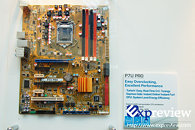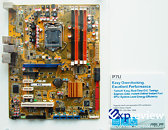- Joined
- Oct 9, 2007
- Messages
- 47,244 (7.55/day)
- Location
- Hyderabad, India
| System Name | RBMK-1000 |
|---|---|
| Processor | AMD Ryzen 7 5700G |
| Motherboard | ASUS ROG Strix B450-E Gaming |
| Cooling | DeepCool Gammax L240 V2 |
| Memory | 2x 8GB G.Skill Sniper X |
| Video Card(s) | Palit GeForce RTX 2080 SUPER GameRock |
| Storage | Western Digital Black NVMe 512GB |
| Display(s) | BenQ 1440p 60 Hz 27-inch |
| Case | Corsair Carbide 100R |
| Audio Device(s) | ASUS SupremeFX S1220A |
| Power Supply | Cooler Master MWE Gold 650W |
| Mouse | ASUS ROG Strix Impact |
| Keyboard | Gamdias Hermes E2 |
| Software | Windows 11 Pro |
During the ongoing CeBIT event, ASUS has two of its newest motherboards on display. Their peculiarity lies in the fact that they are based on the Intel P55 chipset, and have the LGA-1156 CPU socket, supporting the upcoming Intel Core i5 series processors. ASUS chose the "P6T" prefix for naming its first generation of LGA-1366 motherboards based on the Intel X58 chipset. With LGA-1156 and Intel P55 chipset, the company plans to use the "P7U" prefix. The two motherboards on display are the P7U and P7U Pro.
Both motherboards have identical PCB layouts, except for the P7U having a few features toned-down. Both use a (3+1)+2 phase CPU power circuit. Both feature 4 DDR3 DIMM slots for dual-channel memory. Six SATA ports, a PCI-E x4 and a number of PCI-E x1 slots make for the rest of the mix. While the P7U Pro features two PCI-E 2.0 x16 slots (which arrange as x8, x8 when both are populated), the P7U features a single PCI-E 2.0 x16 slot. Both models feature ASUS-exclusive features such as Turbo-V that allows on-the-fly overclocking, ExpressGate that is a basic instant-on OS, and the EPU power management feature.


View at TechPowerUp Main Site
Both motherboards have identical PCB layouts, except for the P7U having a few features toned-down. Both use a (3+1)+2 phase CPU power circuit. Both feature 4 DDR3 DIMM slots for dual-channel memory. Six SATA ports, a PCI-E x4 and a number of PCI-E x1 slots make for the rest of the mix. While the P7U Pro features two PCI-E 2.0 x16 slots (which arrange as x8, x8 when both are populated), the P7U features a single PCI-E 2.0 x16 slot. Both models feature ASUS-exclusive features such as Turbo-V that allows on-the-fly overclocking, ExpressGate that is a basic instant-on OS, and the EPU power management feature.


View at TechPowerUp Main Site







